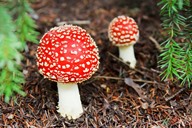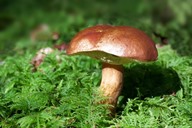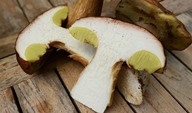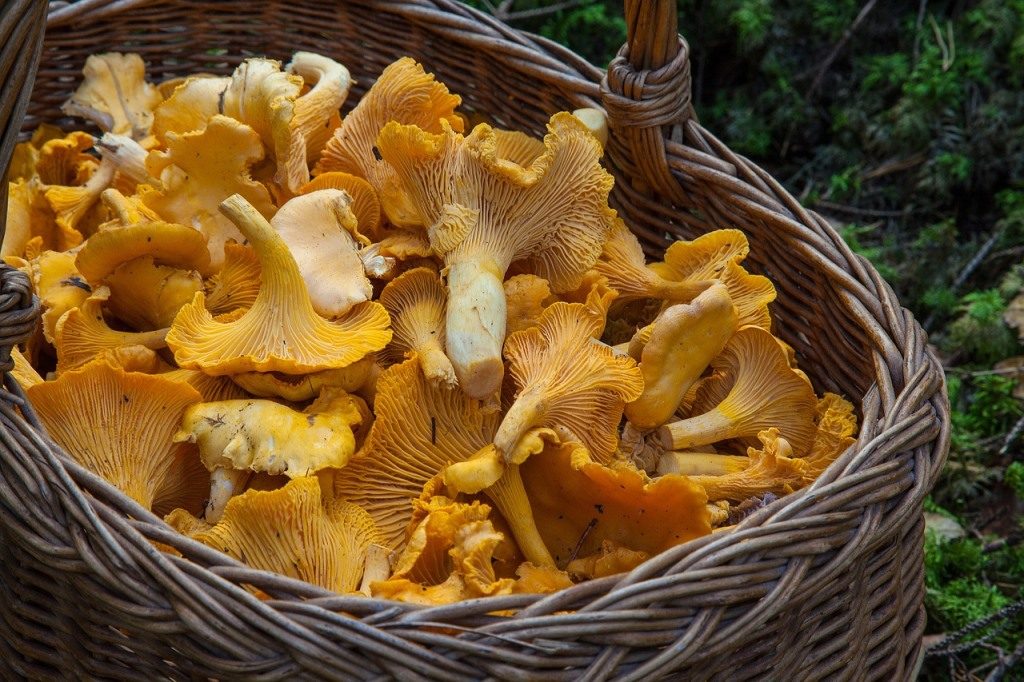 Who would not be very pleased about that – a sunny autumn day in golden October just like we were able to enjoy last week-end. Out for a nice walk, breathing in the fresh forest air and with every step the leaves rustle under your feet. Now and again people can be seen on their way across the fields through the brushwood – why on earth are they are doing that. In all probability these folk are looking for domestic edible mushrooms, of which there are 4,000 – 5,000 types [1]. Because the mushroom pickers will hardly be interested in the countless poisonous varieties – even if these are often wonderful to look at, as the adjacent picture of the fly agaric shows.
Who would not be very pleased about that – a sunny autumn day in golden October just like we were able to enjoy last week-end. Out for a nice walk, breathing in the fresh forest air and with every step the leaves rustle under your feet. Now and again people can be seen on their way across the fields through the brushwood – why on earth are they are doing that. In all probability these folk are looking for domestic edible mushrooms, of which there are 4,000 – 5,000 types [1]. Because the mushroom pickers will hardly be interested in the countless poisonous varieties – even if these are often wonderful to look at, as the adjacent picture of the fly agaric shows.
With the mild temperatures prevailing at present, it is easy, on the moist, mossy forest ground, to find some representatives from the mushroom kingdom such as porcini mushroom/cep, chanterelle mushrooms, chestnuts, little cluster fungus or honey mushroom. Although the main time for mushrooms is in the autumn, March almond woodwax , different types of morel, cup mushrooms or pinecone collybia can be found in the springtime. From May onwards the porcini mushroom season begins. In the early summer the first chanterelle mushrooms and parasol mushrooms start to shoot up. From August there are, in addition, the puffball and the white mushroom types. The latter is the type offered most frequently in supermarkets because it can be cultivated and is therefore available the whole year. It is one of the cultivated mushrooms like the Shiitake mushroom and the oyster mushroom [2].
 As mushrooms cannot carry out any photosynthesis themselves many types of mushroom enter into a symbiosis with plants, for example with forest trees. The network of roots of the mushrooms (mycel) connects up with the tree roots. In this way both organisms exchange nutrients. Mushrooms supply the trees with water and minerals. In return sugar produced by the trees is given back to the mushrooms. But not only are nutrients exchanged in this way, messenger substances whose purpose is to warn the tree neighbours of imminent attacks by pests are also passed on like this, so that other trees can develop defence strategies. Because of this symbiotic way of life mushrooms are often found under forest trees.
As mushrooms cannot carry out any photosynthesis themselves many types of mushroom enter into a symbiosis with plants, for example with forest trees. The network of roots of the mushrooms (mycel) connects up with the tree roots. In this way both organisms exchange nutrients. Mushrooms supply the trees with water and minerals. In return sugar produced by the trees is given back to the mushrooms. But not only are nutrients exchanged in this way, messenger substances whose purpose is to warn the tree neighbours of imminent attacks by pests are also passed on like this, so that other trees can develop defence strategies. Because of this symbiotic way of life mushrooms are often found under forest trees.
Health and nutrition
Mushrooms contain a lot of important nutrients. Above all, they are one of the vegetable suppliers of protein[3] and contain a very high amount of vitamin D and K [4]. As already mentioned in our blog articles, protein is a very important nutritional building block for cancer patients, since it is needed, for example, for the retention or rebuilding of the muscle mass [5].
 Among other things, vitamin D has an influence on the development, multiplication and dying off of cells. In addition, it has an effect on the response of cells of the immune system. These are all central points within the context of cancer formation and also tumour therapy. An anti-carcinogenic effect is therefore attributed to vitamin D and it has been possible to prove this in cell-biological investigations and animal experiments [5]. Even if these initial studies only provide hints and are not necessarily transferable to the human being, they nevertheless provide an important incentive to eat healthily. This nutrition should definitely also include mushrooms.
Among other things, vitamin D has an influence on the development, multiplication and dying off of cells. In addition, it has an effect on the response of cells of the immune system. These are all central points within the context of cancer formation and also tumour therapy. An anti-carcinogenic effect is therefore attributed to vitamin D and it has been possible to prove this in cell-biological investigations and animal experiments [5]. Even if these initial studies only provide hints and are not necessarily transferable to the human being, they nevertheless provide an important incentive to eat healthily. This nutrition should definitely also include mushrooms.
Most people are probably aware of the dependence of the blood thinning system on vitamin K. In the case of a mixed diet one normally takes in sufficient quantities of vitamin K, since it is contained in both vegetable and animal nutrients [4].
According to the Federal Institute for Risk Assessment (BfR) parts of Germany, above all South Bavaria and the Bavarian Forest, are still contaminated with cesium 137 from the Chernobyl reactor catastrophe. Both the cesium content in the surroundings of the mushroom network and also the type of mushroom have an influence on the contamination of mushrooms. The mushrooms which one can buy in the food trade must not exceed a certain threshold value for cesium. Moreover, it seems as if the common mushrooms such as porcini and chanterelle are not contaminated. The BfR advises the consumer who wants to reduce his exposure to radiation to forego self-picked mushrooms in heavily contaminated areas [6].
In the kitchen:
 When preparing mushroom dishes attention must be paid to the fact that many types of mushroom may only be eaten when cooked. In addition, they can be digested better if they are cooked thoroughly for a long time. We advise against freezing them because the taste suffers too much from this. Mushroom dishes should never be kept warm over a long period of time. In addition, one should let them cool off quickly and then store them in the fridge for a maximum of 24 hours. It seems to be possible to re-heat them once again. However, the meal should then be heated up to at least 70 ° C.
When preparing mushroom dishes attention must be paid to the fact that many types of mushroom may only be eaten when cooked. In addition, they can be digested better if they are cooked thoroughly for a long time. We advise against freezing them because the taste suffers too much from this. Mushroom dishes should never be kept warm over a long period of time. In addition, one should let them cool off quickly and then store them in the fridge for a maximum of 24 hours. It seems to be possible to re-heat them once again. However, the meal should then be heated up to at least 70 ° C.
For all mushroom lovers among us, and all those who want to become mushroom lovers, a tasty mushroom recipe from our star chef Hans Haas will follow next week.
Sources:
[1] Deutsche Gesellschaft für Mykologie: Speisepilze, abgerufen am 13.10.2017 von https://www.dgfm-ev.de/
[2] Verband der Köche Deutschlands: Saisonkalender Pilze, abgerufen am 13.10.2017 von http://www.verband.vkd.com
[3] Nestlè Ernährungsstudio Deutschland: Kalorien Mundgerecht, Umschau Verlag, 2014, 15. Aufl.[4] H.-K. Biesalski, P. Grimm und S. Nowitzki-Grimm: Taschenatlas der Ernährung, Thieme Verlag, 2015, 6. Aufl.
[5] H. Bertz, G. Zürcher: Ernährung in der Onkologie – Grundlagen und klinische Praxis, Schattauer Verlag 2014, 1. Aufl.
[6] Bundesinstitut für Risikobewertung: Radioaktive Belastung von Pilzen und Wildbret, abgerufen am 16.10.2017 von https://www.bfs.de/DE/themen/ion/umwelt/lebensmittel/pilze-wildbret/pilze-wildbret.html
